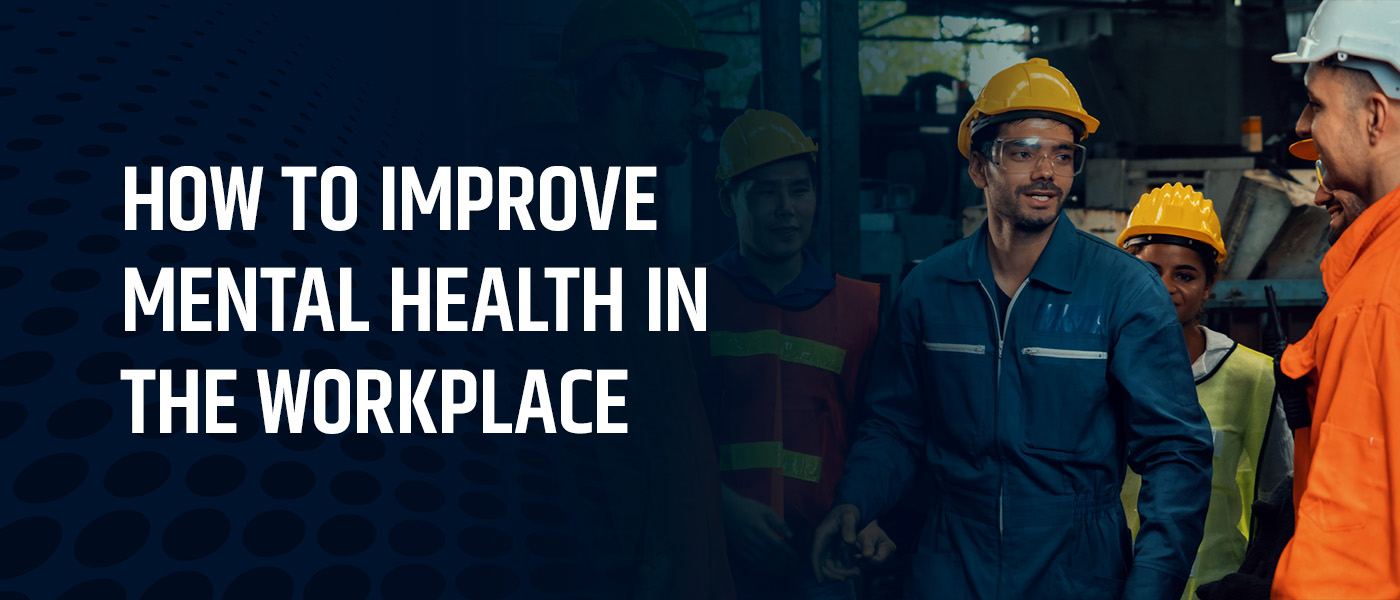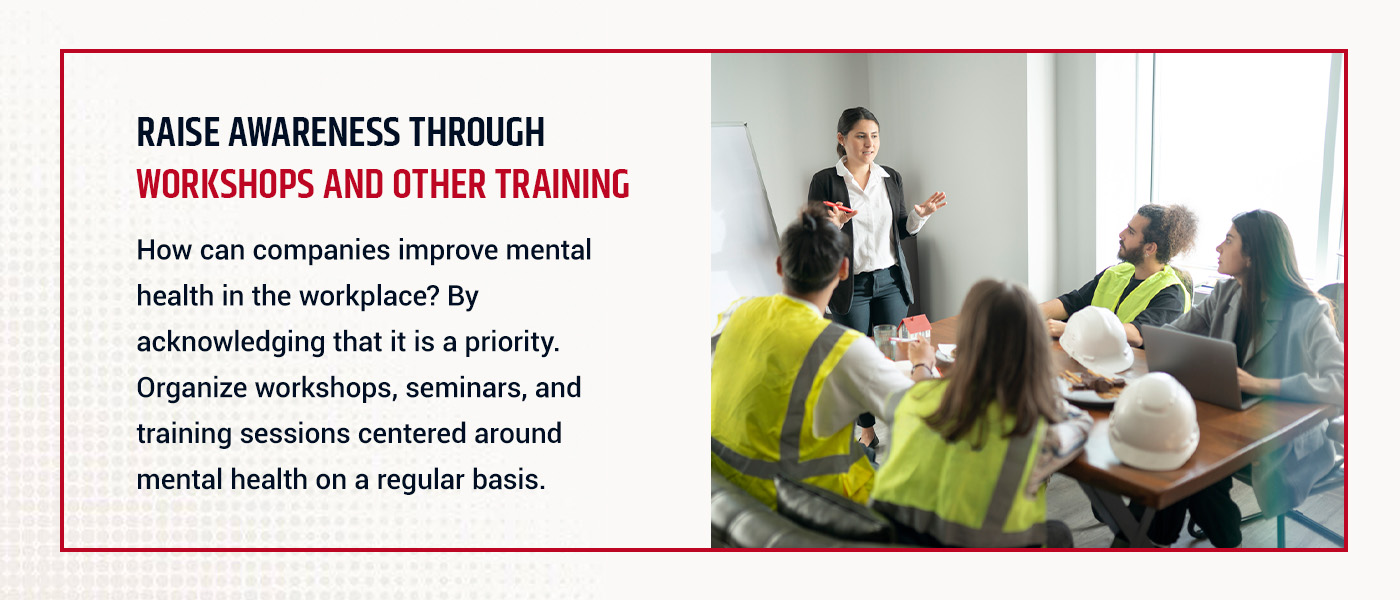How to Improve Mental Health in the Workplace


Mental health in the workplace is an important factor for employers to consider. Good mental health fosters a more productive workforce by enhancing focus and decision-making, among many other benefits.
Prioritizing employees’ mental well-being helps create a more positive work environment by boosting morale and job satisfaction. A focus on mental health also supports a diverse and inclusive workplace, as well as acknowledges and accommodates employees’ mental health needs to ensure equal opportunities.
Here are the top five ways that employers can improve mental health in the workplace.
1. Promote a Supportive Culture
Creating a supportive culture that values mental well-being involves open communication. This “open door policy” emphasizes the role of leadership and encourages employees to feel safe. Improving mental health in the workplace involves allowing employees to open up and discuss any situations they face.
Foster a Culture That Values Mental Well-Being
Take steps to establish a workplace ethos that places mental well-being at its core. By acknowledging the significance of mental health, employers convey its utmost importance. This support helps diminish the stigma related to mental well-being, fostering an atmosphere where seeking assistance is encouraged.
Encourage Open Communication
Promote an environment where employees feel comfortable discussing their mental health concerns. Encouraging open conversations helps break down barriers and allows everyone to share their struggles. By fostering understanding, organizations show their commitment to mental well-being.
Address the Role of Managers and Leaders
Managers and leaders play a central role in shaping an organization’s culture. Their behaviors and attitudes influence how mental health is perceived within the workplace. When managers acknowledge and support mental health initiatives, employees will do the same. Managers set a positive example by prioritizing their own mental well-being and demonstrating work-life balance.
2. Raise Awareness Through Workshops and Other Training
How can companies improve mental health in the workplace? By acknowledging that it is a priority. One way to do this is through educational resources that help employees identify opportunities for better mental health.
Organize workshops, seminars, and training sessions centered around mental health on a regular basis. These sessions offer a valuable opportunity to impart essential knowledge and tools across your workforce.
Publicizing information regarding accessible mental health resources is also a crucial step. Ensure that teams are well-informed about available support systems, including Employee Assistance Programs (EAPs) and counseling services. These resources can help team members reflect on their own mental health as well as spot colleagues who may be struggling. Early recognition enables timely intervention and support, promoting a culture of care within the workplace.
Additional Educational Resources
Here are a few ways to improve mental health in the workplace through a variety of resources:
- Accessible company resources: Make sure that all employees know how to access resources related to mental health. These company resources should dispel myths, make it clear that help is available, and contribute to creating a workplace environment that prioritizes well-being.
- EAPs: These programs offer confidential and professional support for mental health challenges. They provide workers with a safe space to seek guidance and help.
- Counseling services: Immediate access to counseling services and helplines is crucial for those facing urgent mental health needs. These resources offer prompt help, ensuring individuals receive timely support during challenging times.
- Customized resources: Different roles have different needs. Tailoring mental health resources to specific teams enhances their relevance and effectiveness. Customized support ensures that professionals receive assistance aligned with their unique challenges.
- Regular communication: Consistent communication about available resources is essential. Send out regular reminders through various communication channels to ensure employees are aware of the support they can access.
3. Consider Work-Life Balance and Flexible Arrangements
There is a strong connection between mental health and work-life balance — how well someone can balance professional and personal responsibilities. It’s important to acknowledge this correlation in order to foster a more supportive, compassionate workplace culture.
Implementing flexible work hours and remote work options is a tangible way to promote well-being. These choices empower employees to manage their workloads while addressing personal needs. Organizations can show their commitment to employees’ mental health by accommodating individuals and encouraging a sense of control.
It’s also important to discuss the positive impact of these measures on reducing stress and burnout. Flexibility in work arrangements can ease the pressures associated with rigid schedules and lengthy commutes. Employees can channel their energy into their roles as stress levels decrease, enhancing job satisfaction and productivity. Prioritizing work-life balance and offering flexibility helps support a mentally resilient, motivated workforce.
Managing Workloads and Expectations
Effective workload management involves setting realistic expectations, distributing tasks, and empowering team members. These measures support mental health by reducing stressors and enhancing job satisfaction. Employers can help improve mental health in the workplace as it relates to workload by:
- Setting realistic expectations: It’s crucial to set practical expectations for tasks and projects. Unrealistic workloads can lead to stress, while clear, achievable goals promote a healthier work environment.
- Considering workload distribution: Distribute work evenly among team members in order to prevent excessive stress and overloaded individuals. A balanced distribution ensures tasks are manageable and quality remains consistent.
- Encouraging task management: Empowering professionals to manage their own tasks can help improve well-being. Encourage autonomy by allowing individuals to organize their work in ways that suit them best. This sense of control can reduce stress and foster a positive work experience.
4. Offer Mental Health Days
Providing the option of mental health days demonstrates a commitment to employee well-being. It acknowledges the significance of mental health and contributes to a workplace culture that values self-care and balance. Here are a few approaches to consider:
- Focus on mental health: The first step is to recognize that mental health is integral to well-being. Individuals treating mental health like physical health emphasizes the importance of self-care and a balanced life.
- Provide time for recovery: Introduce a policy that allows employees to take mental health days when needed. These days provide time to recover from stress and recharge.
- Foster a supportive environment: Offering mental health days fosters a supportive workplace culture. When employees feel understood and supported in their well-being, they are more likely to perform well and contribute to the organization.
5. Encourage Regular Breaks and Physical Health
Regular breaks and physical health are essential to revitalize employees’ focus, creativity, and productivity. Here are ways to encourage better mental and physical well-being among your employees:
- Encourage short breaks: Taking breaks at regular intervals can reduce stress and enhance productivity. These breaks provide opportunities for mental rejuvenation, enabling employees to better manage stress and maintain focus.
- Promote physical health: Advocate for physical well-being by encouraging regular exercise and healthy eating. It may be helpful to share research studies with employees that show how physical activity and a healthy diet contribute to mood, cognitive function, and overall mental well-being.
- Create a movement-friendly environment: To support physical and mental health, encourage more movement during the day. You can design workspaces that facilitate walking, stretching, and ergonomic adjustments to promote a more active lifestyle. This approach prevents sedentary habits that can have negative effects on well-being.
Learn More from the National Association of Safety Professionals
The National Association of Safety Professionals (NASP) offers safety training and resources to help create safer workplaces across the globe. Contact us today to learn more about how we can help improve your team’s safety through impactful training, online courses, and more.
Related Posts






